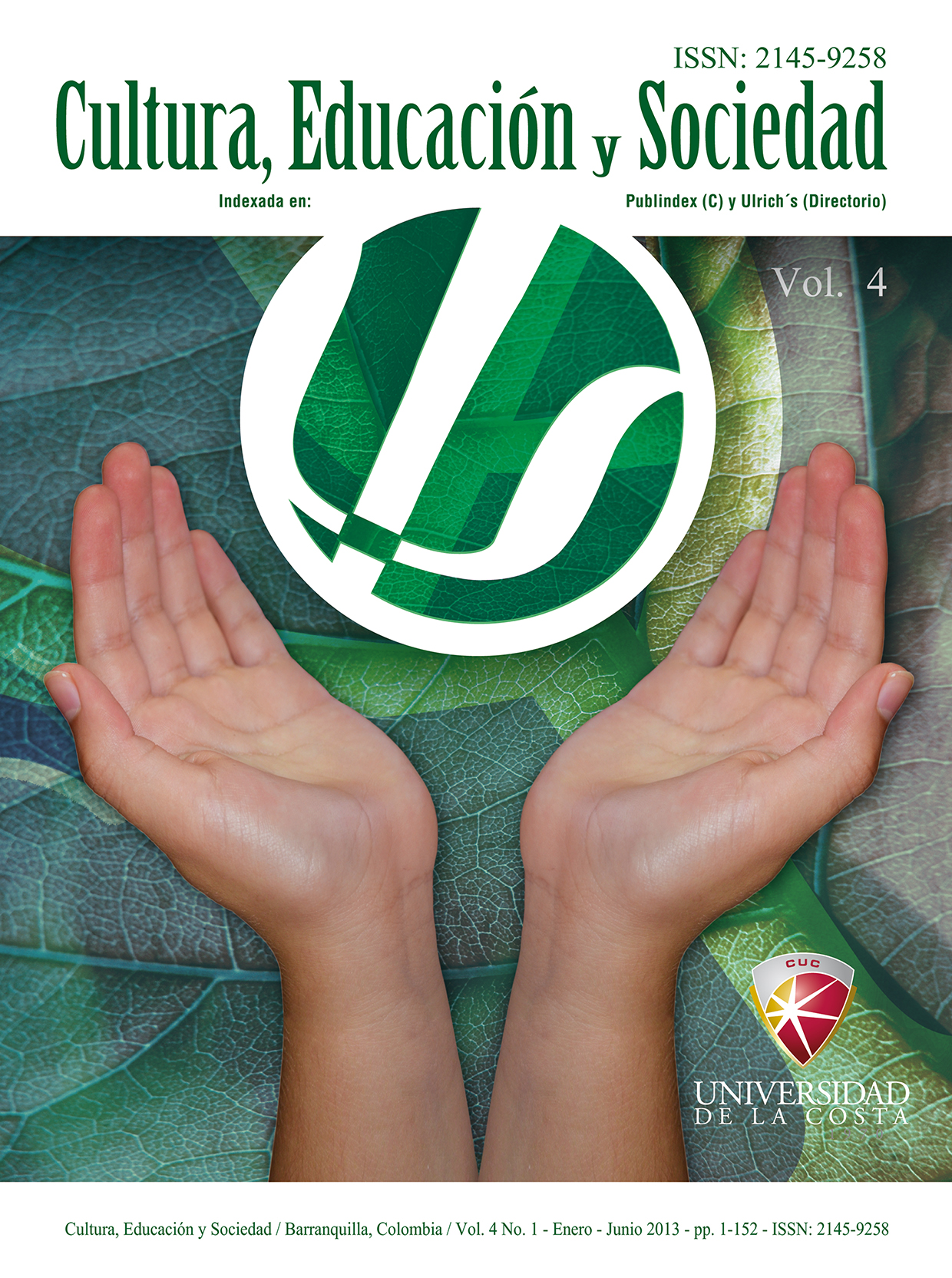Alcohol intake and social behavior in university adolescent male students: an observational study
Keywords:
Social behavior, Alcohol intake, Adolescence, Exploratory data analysis, College students.Abstract
Alcohol intake is a socially accepted activity which usually starts and establishes during adolescence. This research explores the relationship between alcohol intake and social behavior in adolescent men; an observational methodology was performed for exploratory purposes. Eleven college students between the ages of 14 and 19 were observed during six sessions of 15 minutes long within a period of two weeks. The alcohol intake rate, kind of drink and rate of social interactions (positive and negative) were analyzed. These were observed in a shop near the Universidad Cooperativa de Colombia in Neiva. LOGIT model results of these three variables show that the rate of intake is not related to participants’ social behavior, however, it keeps a relation with the kind of drink; though, this study is not enough to explain occurrence of positive and negative social behaviors at alcohol intake contexts.
Downloads
References
Ahmed, S.H. (2005). Imbalance between drug and non-drug reward availability: A major Risk Factor for addiction. European Journal of Pharmacology, 526(1-3), 9-20.doi:10.1016/j.ejphar.2005.09.036
Araújo, N., Fukushiro, D., Cunha, J., Levin, R. y Chinen, C. (2006). Drug-induced home cage conespecifics behavior can potentiate behavioral sensitization in mice. Pharmacology, Biochemistry and Behavior, 84(1), 142-147. doi:10.1016/j.pbb.2006.04.019
Ato, M., Ato, E., y Gómez, J. (2005). Analyzing Change among Developmental Stages with Categorical Models. Quality & Quantity, 39(1), 87-108.doi:10.1007/s11135-004-1048-3
Cáceres, D., Salazar, I., Varela, M., y Tovar, J.(2006).Consumo de drogas en jóvenes universitarios y su relación de riesgo y protección con los factores psicosociales. Universitas Psychologica. 5 (3), 521-534. Recuperado de: www.scielo.org.co/pdf/rups/v5n3/v5n3a08.pdf
Cicua, D., Méndez, M., y Muñoz, L. (2008). Factores en el consumo de alcohol en adolescentes. Pensamiento Psicológico, 4(11), 115-134. Recuperado de: http://portales.puj.edu.co/psicorevista/components/com_joomlib/ebooks/PS11-7.pdf
Dickinson, A., Wood, N., & Smith, J. W. (2002). Alcohol seeking by rats: Action or habit? Quarterly Journal of Experimental Psychology, 55(4), 331-348.doi: 10.1080/0272499024400016
Donovan, J. (2004). Adolescent Alcohol Initiation: A Review of Psychosocial Risk Factors. Journal of Adolescent Health, 35(6), 527-529. doi:10.1016/j.jadohealth.2004.02.003
Espada, J., Pereira, J. y García, J. (2008).Influencia de los modelos sociales en el consumo de alcohol de los adolescentes. Psicothema, 20(4), 531-537. Recuperado de: http://www.redalyc.org/pdf/727/72720404.pdf
Johnson, J., Evers, K., Paiva, A., Van Marter, D., Prochaska, J. Prochaska, J., Mauriello, L., Cummins, C. y Padula, J. (2006). Prevention profiles: Understanding youth who do not use substances. Addictive Behaviors, 31(9), 1593 -1606.doi: 10.1016/j.addbeh.2005.12.006
Kerlinger, F. N., y Lee, H. B. (2002). Investigación del Comportamiento. México: McGraw-Hill.
Martínez, L. (2008). Características del consumo de fármacos psicotrópicos en los estudiantes de Ciencias de la salud de una universidad privada de la ciudad de Medellín. Medellín: Editorial Universidad Pontificia.
Maldonado, A. (1998). El aprendizaje observacional y la adquisición de habilidades complejas. En: Aprendizaje, cognición y comportamiento humano. Madrid: Biblioteca Nueva. pp. 229-254.
Ministerio del Interior. Estudio Nacional de Consumo de Drogas. 2009. Bogotá: Colombia. Recuperado de: http://www1.urosario.edu.co/correo/adminis-tracion/boletines/ODA/documentos/ESTUDIO_NACIONAL_SOBRE_DROGAS_COLOMBIA.pdf
Moreno, J. (2006). Valores, actitudes hacia el alcohol y consumo en adolescentes varones. Límite: revista de filosofía y psicología, 1(13), 195-211. Recuperado de: http://dialnet.unirioja.es/descarga/articulo/2129646.pdf
Observatorio de Drogas de Colombia, Ministerio de Justicia y del Derecho. (2011). Estudio Nacional de Consumo de Sustancias Psicoactivas en Población Escolar. Bogotá: Colombia. Recuperado de: http://odc.dne.gov.co
Ortega, P., Mínguez, R. y Pagán, F. (2003). Actitudes hacia la droga en los alumnos de E.G.B. de la región Murciana. Anales de Psicología, 9(1), 7-18. Recuperado de: http://dialnet.unirioja.es/servlet/articulo?codigo=1325544&orden=55126&info=link
Pons, J. (1998). El modelado familiar y el papel educativo de los padres en la etiología del consumo de alcohol en los adolescentes. Salud Pública, 72(3), 251-266. Recuperado de: http://dx.doi.org/10.1590/S1135-57271998000300010.
Rachlin, H. (2000). The science of self-control. Cambridge: Harvard University Press.
Restrepo, L., Agudelo, A., Tibisay, M., y Sánchez, L. (2011). Factores de contexto asociados al consumo de alcohol en estudiantes universitarios. Revista Salud Pública, 2(2), 136-147. Recuperado de: http://dialnet.unirioja.es/descarga/articu-lo/3818031.pdf
Reyes, G., Gutiérrez, I. y Martínez, C., (2005). Comportamiento ante el alcohol de los estudiantes en las etapas de la adolescencia. Revista Cubana de Medicina General e Integral. 21(1-2), 10-20.Recuperado de:http://scielo.sld.cu/scielo.php?script=sci_arttext&pid=S0864-21252005000100006&lng=es
Spanagel, R. (2003). Alcohol Addiction research: from animal models to clinics. Best Practice & research Gastroenterology, 17(4), 507-518.doi: 10.1016/S1521-6918(03)00031-3
Vermunt, J.K. (1997). Log-linear Models for Event Histories. Thousand Oakes: Sage Publications .
Vuchicnich, R. (1995). Alcohol Abuse as Molar Choice. Psychology of Addictive Behaviors, 9(4), 223-235.doi: 10.1037/0893-164X.9.4.223
Zules, J. D. y Trujillo, M. I. (2012). El marketing de guerrilla como generador de recordación de marca aplicada a la categoría de cervezas en jóvenes de universidades privadas de la ciudad de Santiago de Cali. Tesis de Grado. Cali: Universidad Autónoma de Occidente.
Decreto 120. (2010). Por el cual se adoptan medidas en relación con el consumo de alcohol. Recuperado de: http://www.alcaldiabogota.gov.co/sisjur/normas/Norma1.jsp?i=38680
Downloads
Published
How to Cite
Issue
Section
License
Copyright (c) 2013 CULTURA EDUCACIÓN Y SOCIEDAD

This work is licensed under a Creative Commons Attribution-NonCommercial-NoDerivatives 4.0 International License.
![]()
Creative Commons 2020 CULTURA EDUCACIÓN Y SOCIEDAD
This article is under international license Creative Commons Reconocimiento-NoComercial-SinObrasDerivadas 4.0.
The published articles are the sole responsibility of their authors and do not necessarily reflect the opinions of the editorial committee.
CULTURA EDUCACIÓN Y SOCIEDAD respects the moral rights of its authors, who assign to the editorial committee the patrimonial rights of the published material. In turn, the authors inform that this work is unpublished and has not been previously published.
All articles are under a:
Licencia Creative Commons Atribución-NoComercial-SinDerivadas 4.0 Internacional.
![]()


 English
English
 Español (España)
Español (España)




_12.53_.27_p_. m_._3.png)





_12.57_.35_p_. m_._3.png)
_12.50_.37_p_. m_._3.png)



